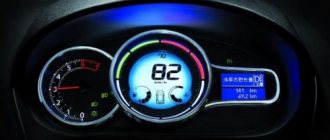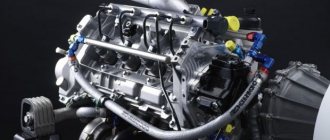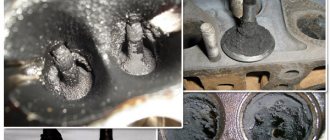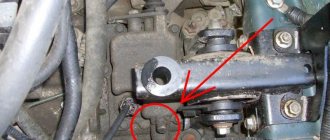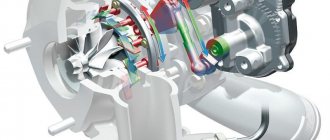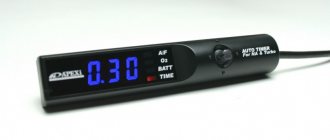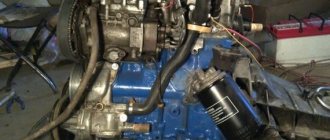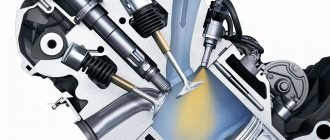About automobile gas equipment
Gas-cylinder equipment must ensure safe storage, supply, as well as full operation of internal combustion engines using “blue” fuel. As we know, methane or propane-butane is used for cars. The first is in a compressed state, the second is in a liquefied state.
After switching the car to gas, the main type of fuel is used as usual. The factory power supply system does not change much during the installation of gas equipment; to a greater extent, it is only supplemented with special units for gas. As a result, the equipment is capable of operating on both types of fuel with separate or even simultaneous supply. The combustion of the gas-fuel mixture occurs according to the same physical laws as when working on the main fuel. You can learn more about the operation of the equipment by reading the article “GBO for a car.”
Dual Fuel System
This is exactly the scheme used on some modifications of MAZ and KamAZ trucks. This is a combined fuel supply system. At the moment this is the cheapest, correct and easily implemented option. The cost of the alteration is about 70-85 thousand rubles. The peculiarity of the system is that there is no need to install spark plugs. Diesel fuel itself is used to ignite methane (or propane-butane). As for the main components of the system, these are the same gas reducer, hoses and lines, as well as fuel storage cylinders.
Diesel features
Almost all of the above has little to do with diesel. The operating cycle of a diesel unit differs from a gasoline unit in the way the mixture is formed and ignited. The fuel-air mixture is formed directly in the cylinders. First, air is supplied to the cylinders, and then diesel fuel is injected, which ignites under the influence of temperature or compression pressure. A spark is not needed, and by definition there is no ignition system here. By design, the diesel engine can have a separate combustion chamber and direct injection.
In the first version, the chamber and cylinder are separated. In the second, fuel is supplied to the space above the piston (chamber on the piston). The fuel equipment of a diesel engine is more complex than that of a gasoline engine, since a more precise supply is required in terms of time, volume and pressure. To facilitate cold starts, glow plugs are used to preheat the air in the combustion chamber. There can be two pumps here - high and low pressure. It is these features that raise doubts about the possibility of using HBO.
Is it possible to install LPG on a diesel engine?
Now let’s talk about whether it is possible to install HBO on a diesel engine. Structurally, such a unit differs little from a gasoline unit. The implementation of the idea is complicated by the fact that the gas does not ignite due to compression. Therefore, the use of a small amount of diesel fuel is provided here. It is not pure gas that is supplied to the cylinders, but a mixture of it with diesel fuel in a ratio of three to one. This allows diesel injectors to remain in operation and fuel equipment to remain in good working order.
In other words, a system such as fifth-generation gas equipment operates, in which liquid gas is supplied to the cylinders. That is, the implementation will be complex, expensive, but quite realistic. Gas has a higher octane number, increasing the stability of the diesel engine. This option is extremely beneficial for trucks and special equipment.
Installing LPG on a diesel engine also reduces harmful emissions and improves the efficiency of a passenger car.
Moreover, a methane unit can be installed on a diesel engine. Its use will make it possible to reduce the percentage of expensive diesel fuel in the overall mixture, which will further increase the attractiveness of such a solution.
LPG for diesel with turbine
The validity of the use of turbines on diesel engines has been proven by science and practice. Actually, the operation of the turbine cannot be affected in any way by the composition of the fuel mixture. And in this regard, there are no special features regarding the installation and use of HBO.
Economic effect
The most important thing here is monetary interest. The higher the oil price, the better gas fuel systems will develop. Developers are constantly developing systems, providing more and more diesel engines. The most important thing is the availability of appropriate gas stations.
Advantages of gas
Replacing fuel with gas provides the following advantages:
- Save time and money.
- Since the gas will burn better, all the characteristics and power of the car will increase.
- The engine will run quieter.
You might be interested >> Features of the transition of Lada Vesta to LPG
Flaws
But there are some disadvantages:
- Installing LPG on a diesel engine is not a cheap pleasure.
- Problem with gas stations. Not all places have the option to purchase methane.
- You will only benefit from diesel fuel gas if you travel long distances in your car. That is, when more than 50 thousand kilometers are covered in a year.
As you can see, all the shortcomings relate only to the price of materials. There is nothing that reduces the technical aspects of the vehicle.
LPG on a diesel engine - principle of operation
Now we will explain how LPG for a diesel engine works. Gas flows from the cylinder to the gas valve, is cleaned in its filter and passes to the reducer, where it evaporates (propane) or expands (methane), then enters the mixing chamber in front of the injectors (on the latest generations without evaporation directly to the injectors) and is sent to the combustion chamber .
There it mixes with diesel fuel and air, after which it ignites. The fuel supply is controlled by the ECU, which receives signals from standard and additionally installed sensors.
Operating principle of HBO
The liquefied gas (methane gas) passes through the multivalve and enters the high pressure line. There it is filtered through a gas filter and enters the evaporator reducer (simply a reducer for methane) and enters the combustion chamber through a dosing device or nozzles. In it, it either mixes with diesel fuel or burns like gas - depending on the method of installing the gas equipment. The process is controlled by an electronic LPG control unit: based on sensor readings, it makes adjustments to the quantity of the mixture, its quality and ignition.
Installing and configuring an LPG kit for diesel engines is a complex procedure, and it must be performed by professionals.
Author: A. Kopylov
Diesel equipment options
Let's start with the fact that there is a difference in equipment for methane and propane. A methane diesel engine is good for large vehicles due to the difficulties of placing cylinders. Passenger cars are often equipped with propane; in addition, it is liquid, and this simplifies adaptation. There are two known options for such re-equipment:
- Complete.
- Gas diesel.
Complete refurbishment
This option is usually chosen when installing equipment for methane. In this case, a serious modification of the engine is required, after which it will be able to run exclusively on gas. The ignition temperature of methane is twice as high as that required for diesel fuel. Also, you don't have to squeeze it so hard or it won't light at all. For everything to work, it is necessary to reduce the compression ratio and install an ignition system. And here it doesn’t matter whether the diesel is propane or methane.
The first task is solved by sampling the metal and installing a metal gasket under the head. Spark plugs take the place of diesel injectors, and gas fittings cut into the intake manifold. After such a modernization, it is difficult to return the motor to its original state, and the installation itself is complicated. At the same time, it is already difficult to call diesel by its proper name, since it will not be able to run on diesel fuel.
Gas diesel installation
It is for the above reasons that gas-diesel has become more widespread. This is the best option for working on propane-butane. Such a motor will operate on diesel fuel or a mixture of gas with it, but will not be able to operate on pure gas.
The procedure and work order are practically no different from the installation of a standard gas equipment. And it works like this. Gas enters the cylinder on the intake stroke. Pilot fuel (diesel fuel), necessary for ignition, is injected at the end of the compression stroke, when a gas-air mixture has already formed in the cylinder. All this ignites and so on.
Why is it difficult to convert a diesel engine to gas?
- Ignition temperature. If in a diesel engine the fuel spontaneously ignites at 400 degrees, then gas burns at 700 and above. And it doesn’t matter whether it’s methane or propane-butane.
- No candles. Whatever the compression ratio in a diesel engine, it will not be enough to heat the gas mixture to the auto-ignition temperature. Therefore, you cannot do without installing third-party spark plugs.
- Octane number. Diesel fuel has an OC of 50 units. Gas has at least 102. If such fuel gets into a diesel engine, it will go into overdrive (this is uncontrolled engine operation at high speeds). There are several ways to solve the problem. This is a correction of the compression ratio, or a decrease in the octane number of the gas mixture.
What does LPG for diesel include?
The brain of HBO for diesel engines is the control computer or ECU. Based on the analysis of information from sensors, it generates control signals for the supply of gas and diesel fuel.
The rest of the gas equipment set may differ, but, in addition to the cylinder, reducer, multi-valve, gas valve and lines, includes:
- gas injectors/dispenser;
- mechanism for moving the injection pump rack. The high pressure pump will require modification;
- temperature, synchronization, crankshaft, gas sensors and others. Part of the staff is used;
- low and high pressure gas filters.
Where should it be installed
As already noted, installing gas equipment on a diesel engine is highly complex. Therefore, this is a job for specialists who understand the intricacies of the issue. The installer must be licensed, and the list of works includes setting up and testing gas equipment. The installer will complete the necessary documents for registration and will subsequently perform periodic maintenance and inspections.
You can install LPG on a diesel engine on your own, but no one can guarantee the quality of work and operational safety. If you get to the heart of the matter, the procedure may not seem so complicated. The savings will be significant, but only if serious mistakes are avoided.
It may seem that installing a gas diesel engine differs little from the usual one. But we note that some work in garage conditions is impossible to perform efficiently. It's about setup, first and foremost. This cannot be done without a special stand.
HBO operation on a diesel engine
The fact is that diesel fuel ignites due to pressure, while gas does not burn under such conditions. The process goes like this: first, a reduced portion of diesel is supplied, which serves as an igniter, and then gas is injected. In this case, gas injectors operate in parallel with diesel ones.
The gas-diesel ratio depends on the speed: the lower the engine speed, the more diesel fuel is injected; in practice, the ratio is 50/50 when it comes to propane. Methane allows you to increase the gas share to 75-80%. The best performance in favor of gas occurs when driving on the highway.
What documents are needed
According to TR CU 018/2011, the installation of gas equipment is a retrofit. In accordance with Art. 12.5, part 1 of the Code of Administrative Offenses of the Russian Federation, operating a car without registering changes is prohibited, so you will have to go through the procedure at the traffic police. You will need an application, passport, SOP, PTS, equipment certificates and installer licenses, diagnostic card and fee payment receipt.
The received certificate of conformity and a passport for LPG with marks must be carried in the car. Before visiting the State Traffic Inspectorate, it is advisable to find out how to obtain the necessary documents for LPG for a car.
How to register HBO
The process begins with obtaining permission to install. A corresponding application is submitted to the traffic police. The installer will issue an acceptance certificate and a declaration of the scope of work performed. After passing the inspection, you should contact the traffic police again with a package of documents and a request to make changes. The car is provided for inspection.
According to the Order of the Ministry of Internal Affairs dated December 7, 2000 N 1240, employees will issue a SKTS, a new SOR and make notes in the PTS on the day of application. You will find more useful information in the article “Registration of HBO in the traffic police.”
Drawing conclusions
LPG for a passenger car diesel engine provides the following advantages:
- good savings;
- increase in resource and power (by 25-30%);
- quieter, more stable and smoother operation;
- a noticeable reduction in the level of harmful emissions.
The disadvantages include high complexity and cost, problems with starting at sub-zero temperatures, as well as the inability to use only gas in the case of gas-diesel and, conversely, diesel engines with a complete conversion. It is also important to mention the complexity of dismantling, the shortage of gas stations and licensed service stations.
